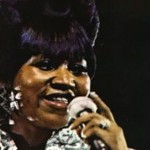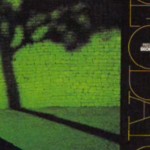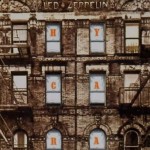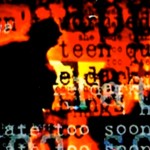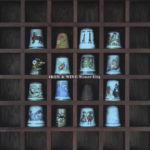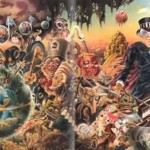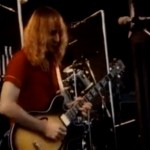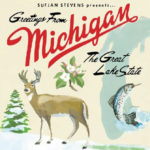- Films Watched: The Battle of Algiers dir. by Gillo Pontecorvo; Down by Law dir. by Jim Jarmusch; Saraband dir. by Ingmar Bergman; 35 Up dir. by Michael Apted
- Books Finished: Libra by Don DeLillo; The Content of the Form: Narrative Discourse and Historical Representation by Hayden White; The Polysyllabic Spree by Nick Hornby
- CDs Purchased:
Howl by Black Rebel Motorcycle Club; Pixel Revolt by John Vanderslice; Donnie Darko (soundtrack) by Michael Andrews
Remember that episode of The Office when David Brent interrupts a training seminar to sing his ode to the free love freeway? The comedy in that scene is about a mile-and-a-half thick. There’s the typical embarrassment of Brent’s colleagues, there’s Tim’s disbelieving stares into the camera and Gareth’s interruptions (“She’s dead”), but what I most love about the joke is that Brent, a middle-aged paper salesman from Slough, has written — and is earnestly performing — a song about driving a Cadillac through the American southwest, bedding lovely “senoritas” along the way.
Oh, dear lord, how I wish I could chalk up Black Rebel Motorcycle Club’s new album Howl to an extended exercise in irony. Generally speaking, I avoid power-trio rock-and-roll, but BRMC’s last record Take Them On, On Your Own was one of my favorites of 2004. It’s heavy when it needs to be but also features melodic songwriting and great guitar noise. Howl, apparently, is their attempt at “roots” music. Acoustic guitars? Check. Harmonicas? Check. T-Bone Burnett credit? Check. Song titles that make confused, sepia-toned allusions to southern spirituality and Depression-era heartache? Check. Apparently these California boys turned off their Jesus and Mary Chain records just long enough to watch O Brother Where Art Thou seven or eight times, and now they’ve lost their way in the funhouse of Americana simulacrum. Fortunately, The Disc Exchange has a ten-day return policy, so I’ll be getting that New Pornographers album instead.
The week wasn’t a total bust for new music, though. After spending most of the last month listening obsessively to John Vanderslice’s “Exodus Damage,” I picked up the new album, Pixel Revolt, and it’s a beaut’. Vanderslice is a story-teller. Okay, so that’s not terribly unusual. But he’s a story-teller who works in genres. For example, “Continuation” is a police procedural. Seriously, it’s sung by a detective who’s working a case. And it has a cello solo. You’re probably going to laugh at some point during the first twenty-two seconds of the song. Then Vanderslice will start singing, and by the time he hits the chorus, you’ll be tapping your foot and smiling.
Still high from the Miranda July film, I also picked up a used copy of the Donnie Darko soundtrack this week. (Both films were scored by Michael Andrews.) Except for its inclusion of three, barely-distinguishable versions of “Mad World,” I like it a lot. Maybe instead of a Fender Rhodes, I should be on the lookout for a Mellotron.
Another week, another book of critical theory, another postmodern doorstop. In The Content of the Form, Hayden White asks, “Could we ever narrativize without moralizing?” For White, the interpretation of history, like the acts of fiction-making and criticism, is a moral and political act. Reading White alongside Don DeLillo’s Libra made for an interesting study of theory and praxis. DeLillo’s “Author’s Note,” included on the last rather than first page, reads:
This is a work of imagination. While drawing from the historical record, I’ve made no attempt to furnish factual answers to any questions raised by the assassination.
Any novel about a major unresolved event would aspire to fill some of the blank spaces in the known record. To do this, I’ve altered and embellished reality, extended real people into imagined space and time, invented incidents, dialogues, and characters.
Libra, in effect, is about the writing of history, the transformation of “real” events into a narrative. It’s a job, DeLillo implies, shared by novelists, historians, CIA analysts, politicians, and anyone else — Lee Harvey Oswald, for example — who writes themselves into human history. That’s an admittedly pedantic description of a novel that was honest-to-god fun to read. I was blissfully ignorant of the JFK assassination before picking up the book, so I was swept quickly into the various intrigues and conspiracies. I have no idea at this point how much of the novel is “real,” which, I guess, is precisely the point.
If I watched fewer films this week, it’s because much of my spare time was spent parsing through the list of 256 features and 79 shorts that will be playing at TIFF this year. Again, I’m holding off on commenting on the 7 Up films until I finish them all, and I have a longer response to Saraband in the works, which leaves only The Battle of Algiers and Down by Law. I missed Algiers during its theatrical re-release a year or two ago, and I’m sort of glad that, instead, I was able to see it now, at some remove from Bush’s march to war and the prison abuse scandals. That Pontecorvo’s film was made forty years ago, and that America now finds itself in a situation so similar to colonial France’s (the same arrogance, the same disregard for history, the same dehumanizing mistakes), is just maddening. It’s almost too much to watch — and I mean that as the most sincere compliment. Again, Doug has two really fine essays on the film and the DVD release.
Down by Law is also a great film, and for completely different reasons. What happens in Jarmusch’s film is irrelevant — three guys are arrested and make a jailbreak — all that matters is that it happens to three guys who are endlessly watchable. John Lurie doesn’t so much act as simply embody cool. In fact, I like him best when he’s standing still or functioning as the straight man. Tom Waits is Tom Waits is Tom Waits. And Roberto Benigni, despite what you might think of him after Life is Beautiful and the Oscars, has some kind of superhuman comic timing and this crazy gift for swinging effortlessly between mania and pathos.
When I first mentioned Nick Hornby’s The Polysyllabic Spree, Bulb wrote in a comment, “I left [a copy] in my guest bathroom and it never fails to elicit favorable comments.” I don’t mind admitting that I read most of Spree two or three pages at a time. It’s great in small doses. Hornby tells us what he read, why he read it, and whether it was worth the effort, and he does so in a typically charming and insightful manner. I can’t write fiction. It’s a complete mystery to me. Which is why I so enjoy reading writers write about writing. Best of all, Spree has given me an unexpected and much-needed push toward the book shelf (and the blog).

